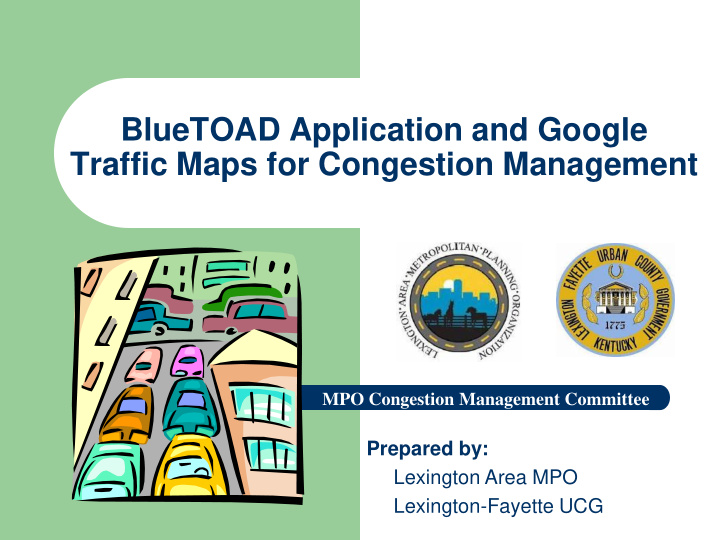



BlueTOAD Application and Google Traffic Maps for Congestion Management MPO Congestion Management Committee Prepared by: Lexington Area MPO Lexington-Fayette UCG
Where is Lexington KY? Lexington KY
KY and Lexington Area MPOs Lexington Area MPO is one of the 9 MPOs in the State of Kentucky.
Lexington Area MPO and LFUCG Lexington Fayette Urban County Government (LFUCG) Jessamine County Population – 2015: 314,488 (Fayette Co.) 50,815 (Jessamine Co.) 489,435 (Six Co. MSA)
Purpose and Preview Traffic Congestion measures and travel-time reliability BlueTOAD application introduction and overview BlueTOAD data collection and processing capabilities How can Google live and typical traffic maps help Other data sources, tools, and present/future work
What is Traffic Congestion? “The level at which transportation system performance is unacceptable due to traffic interference and excessive travel times/delays. ” The level of system performance deemed acceptable by State and local officials may vary by type of transportation facility (major or minor arterial), geographic location (urban or rural area), and/or time of a day. Source: 23 CFR Sec. 500.109
Types of Congestion 1. Recurring 2. Non-recurring
Recurring Congestion Causes of Congestion Bottlenecks, lack of lane/road capacity Excess Demand Commuters & SOVs Seasonal Long-term construction
Non-Recurring Congestion Causes of Congestion Crashes/Incidents Disabled Vehicles Special Events Weather Utility Work / Maintenance / Short-term Construction Goods and Service Deliveries
What are the congestion statistics? Source: www.ops.fhwa.dot.gov/
How to measure congestion and travel time reliability? Three (3) indices and formulas have been recognized by FHWA to measure congestion and Travel Time (TT) reliability. Travel Time Index (TTI): TTI = Average Travel Time (TT) / Free Flow TT Buffer Time Index (BTI): BTI = (90 th or 95 th TT – Average TT) / Average TT Planning Time Index (PTI): PTI = 90 th or 95 th TT / Free Flow TT Source: www.ops.fhwa.dot.gov/
BlueTOAD (Bluetooth Travel-time Origination And Destination) Reliable data using MAC address pairing Cellular and/or Ethernet communications Real-time network and device monitoring For use on arterials and freeways
How BlueTOAD system works? Hardware: Web based Backend: Filters/Algorithms: Web Hardware based
BlueTOAD Report System Dashboard
BlueTOAD Lexington KY Speed Map
BlueTOAD System Device Pairs
BlueTOAD Benefits Transportation Planning • • Collect data for transportation planning and traffic modeling • Help identify, develop and prioritize projects • Collect data for before & after studies to report the effectiveness of improvement projects • Congestion Management • Identify congested roadway segments and intersections • Determine congested time of a day and duration • Quantify congestion levels using congestion indices • Monitor congestion changes over time and trends.
BlueTOAD Benefits Signal Timing • • Testing of coordination plans to ensure effectiveness • Ability to collect data in order to measure construction impacts. • Ability to compare time of day coordination plans in order to choose most appropriate plan. • Emergency Services • BlueTOAD can be use to measure accident clearance times. • Can be used to measure lasting affect that a collision may have on traffic before returning to normal.
BlueTOAD Information Comparisons
Bluetooth Technology Pros and Cons Advantages: Disadvantages: Mobile Units allow for Monthly Costs flexibility with data capture. Possible Coverage Issues Customize Sample Periods Maintenance Compare multiple traffic events. Calculate Congestion and reliability Indices Publish travel times to the public
Man O War Blvd Monthly & Annual TTI Comparisons Using BlueTOAD Data (Monthly Weekdays) Rout Name: Man O War Blvd. - Eastbound (EB) Start: MOW/Nicholasville Rd TTI = Average Travel Time / Free Flow Travel Time End: MOW/Sir Barton Way Route Length: 8.70 miles A = AM Peak (From 6 a to 9 a) BlueTOAD Devices: 7 pairs Free-flow Speed: 45 mph P = PM Peak (From 4 p to 7 p) AM Peak PM Peak 2014A 2015A 2014P 2015P 2.50 J 1.33 1.27 1.41 1.46 F 1.38 1.34 1.52 1.57 2.00 M 1.66 1.37 1.94 1.58 A 1.38 1.38 1.52 1.60 1.50 2014A M 1.29 1.31 1.49 1.65 2015A J 1.24 1.26 1.47 1.53 2014P 1.00 J 1.25 1.27 1.44 1.54 2015P A 1.26 1.36 1.46 1.55 0.50 S 1.28 1.35 1.48 1.52 O 1.34 1.39 1.57 1.64 0.00 J F M A M J J A S O N D N 1.27 1.37 1.54 1.67 D 1.29 1.33 1.64 1.69
National Travel Time Index Source: http://governing.typepad.com
When are the worst AM and PM peaks in a week? Worst AM Peaks: Tue and Wed from 7 am to 8 am Worst PM Peak: Fri from 4 pm to 6 pm
Typical Traffic: Wed, 7:50 AM, 2015 Record
Typical Traffic: Fri, 5:00 PM, 2015 Record
National Travel Time Index Source: FHWA 2015 Urban Congestion Trends
Annual Congestion Trend Monitoring Sunny, 47F. Wind:6mph Wed 7:50 am 14Oct2015
Annual Congestion Trend Monitoring Fair, 64F. Wind:15mph Fri 5:10 pm 16Oct2015
Present and Future Work BlueTOAD TTI data monthly & annual comparisons BlueTOAD corridor pair and route studies BlueTOAD data to study lane blockage impacts Google live / typical traffic map screen-shots BlueTOAD and Google traffic map comparisons
Other data sources and tools LexingtonKY.gov: TMC and “Real - time” Traffic Ticker LexingtonKY.gov: Video Distribution Mgmt. System Lane Blockage Reporting to Waze via Accela Software Kentucky 511 Traffic and Travel Information MapQuest, TomTom, and Waze live traffic maps/cams
Review and Summary Traffic Congestion measures and travel-time reliability BlueTOAD application introduction and overview BlueTOAD data collection and processing capabilities How can Google live and typical traffic maps help Other data sources, tools, and present/future work
Lexington Area Congestion Management Process (CMP) Contacts Key Contacts: Sam Hu – MPO Senior Planner shu@lexingtonky.gov David Filiatreau – LFUCG Signal Systems Mgr. dfiliatreau@lexingtonky.gov Max Conyers – MPO Planning Manager Barry House – CM Committee Chair Questions and Comments?
Recommend
More recommend